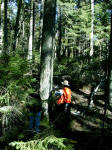|
Bartlett Experimental Forest
|
In 1931-32 the Bartlett Forest was gridded with 500 permanent 0.1-ha square cruise plots spaced 200 by 100 meters apart. After an initial measurement of all woody stems larger than 1.5 inches (3.8 cm) in diameter, a majority of the plots (441) were remeasured by 1-inch (2.54 centimeters) diameter classes and species in 1939-40 and again in 1991-92. This 60-year data set includes areas (55%) that were cut for experimental purposes using single-tree selection, diameter-limit cutting, group selection, clearcutting, shelterwood, and thinning.
Another 45% of the Forest has not been harvested since at least 1890. The Forest has no history of recent fires, but a 1938 hurricane did substantial damage, particularly at the higher elevations, and the area sustained severe damage from beech-bark disease in the early 1940's. Two other natural disturbances may be occurring on this Forest: red spruce decline associated with acid deposition and migration of tree species upslope as a result of climate warming.  Wildlife species on the Bartlett Experimental Forest depend on the array of surrounding forest and riparian habitats on the extensively forested mountain slopes. Nonforested and aquatic habitats are minor components of the overall landscape. At least 15 species of amphibians and reptiles, 90 bird species, and 35 mammalian species have been known to occur in the area throughout the year. Charismatic megafauna like moose and black bear can be seen: redback, spring and two-lined salamanders and wood frogs are also found, as well as a number of raptors (red-tailed hawk, goshawk, barred owl, and saw-whet owl), a variety of neotropical migratory birds, permanent residents (crossbills and redpolls); and an array of bats, small mammals, forest carnivores (weasels, fisher, bobcat), snowshoe hare, and white-tailed deer. Wildlife species on the Bartlett Experimental Forest depend on the array of surrounding forest and riparian habitats on the extensively forested mountain slopes. Nonforested and aquatic habitats are minor components of the overall landscape. At least 15 species of amphibians and reptiles, 90 bird species, and 35 mammalian species have been known to occur in the area throughout the year. Charismatic megafauna like moose and black bear can be seen: redback, spring and two-lined salamanders and wood frogs are also found, as well as a number of raptors (red-tailed hawk, goshawk, barred owl, and saw-whet owl), a variety of neotropical migratory birds, permanent residents (crossbills and redpolls); and an array of bats, small mammals, forest carnivores (weasels, fisher, bobcat), snowshoe hare, and white-tailed deer.
The most serious problem facing woodland managers in the Northeast is a lack of knowledge about the ecological relationships between wildlife habitat and forest management in northern hardwoods and associated ecosystems at various levels. This information is essential for integrating wildlife habitat maintenance and improvement with other forest management goals including timber production and maintenance of aesthetic qualities. If you would like to know more (alot more) please visit the US Forest Service Northern Research Station at this Address: https://www.fs.usda.gov/ne/newtown_square/publications/brochures/pdfs/experimental_forests/Bartlett.pdf (This is the same place I lifted this little story from, but since our taxes are probably paying for most of it, I think it's OK))
What's Going On up in Them Woods ?
|
The Bartlett Experimental Forest is within the Saco Ranger District of the White Mountain National Forest in New Hampshire. It is managed by RWU-4155 of the Northern Research. Station.
 Research activities began at the Experimental Forest when it was established in 1931 and is 2,600 acres in size but will likely double in area with the forest plan revision that is being written. The BEF extends from the village of Bartlett in the Saco River valley at 680 ft to about 3,000 ft at its upper reaches. This particular site was chosen because it represented conditions (soils, elevation, climate, tree species composition) typical of many forested areas throughout New England and northern New York. The White Mountain National Forest , including the BEF, was purchased under the Weeks Act of 1911. In the late 19th century, the area was selectively logged for high value species, first eastern white pine and red spruce and later sugar maple and yellow birch. Logging railroads were laid and hardwood stands were clearcut for locomotive fuel. The lower third of the BEF was logged and some portions cleared for pasture.  Upper portions were progressively less impacted with increasing elevation. Although fires are relatively rare, the 1938 hurricane did widespread damage. High grading resulted in more American beech, so when the beech scale-Nectria complex, or beech bark disease, arrived in the 1940s it caused substantial damage and continues to influence stand dynamics. An ice storm in 1998 was the most recent widespread natural disturbance, impacting mostly higher elevation stands. Occasional wind storms are common disturbances, but of relatively small scale. There are areas of old-growth northern hardwoods with beech, yellow birch, sugar maple, and eastern hemlock being the dominant species. Even-aged stands of red maple, paper birch, and aspen occupy sites that were once cleared. Red spruce stands cover the highest slopes. Eastern white pine is confined to the lowest elevations. SEE SOME 1935 PHOTOS OF LOGGING ACTIVITY IN THE FOREST. |
